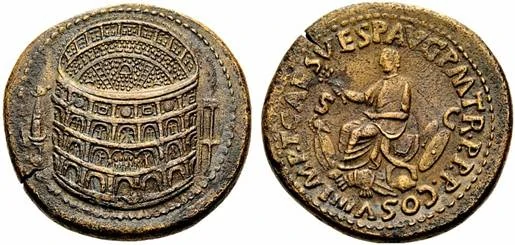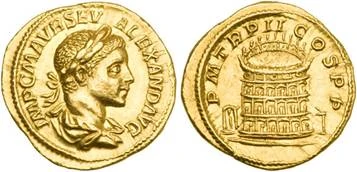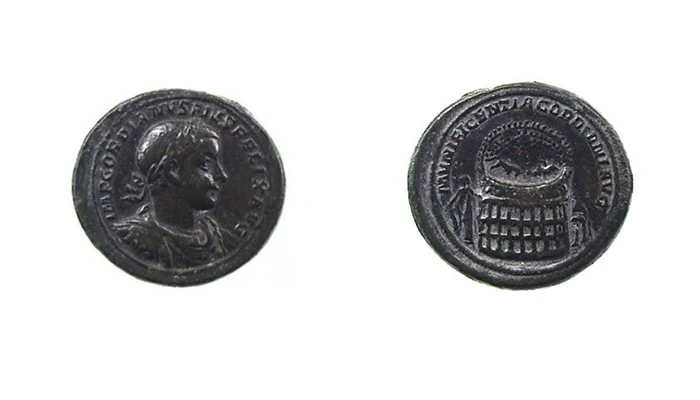
- On 3 February 2023
- In Curiosity
- Tags:
Colosseum on coins
The Coliseum, originally known as the Amphitheatrum Novum, is one of the most famous monuments in the world and also one of the most impressive, due both to its immense size and the extent of the games held there. The construction dates back to between 70 and 80 AD, and was ordered by the first two emperors of the Flavian dynasty – Vespasian and Titus. Domitian, the last emperor in this family, finished the building and constructed the underground area. From the very start of the story of the Coliseum the only images we have today are those represented on a small amount of coins. These coins in Ancient Rome were a very efficient form of propaganda, due to their ‘serial’ nature, excluding the relief of the Hateriì, where the Coliseum appears up to the third story.
The coins with images of the Coliseum are well known and have been studied in detail, nonetheless we would like to discuss them briefly here.
Contents
Examples from the time of Titus and Vespasian. Currency or largess?
The very first coins representing the image of the Coliseum are a series of sestertii (twelve in all have been found) from the time of the emperor Titus and his brother and successor, Domitian. The sestertius was a coin issued in silver during the Republican era and was worth one quarter of a denarius or two and a half assii. Following the revaluing of the denarius to sixteen assii, the sestertius was later worth four assii. In Imperial times the sestertius was issued in oricalcum, an alloy similar to brass. The sestertius weighed 25/28 grams, with a diameter of 32/34 mm and a thickness of circa 4 mm. The ample surface space was ideal for representing images linked to imperial propaganda.
The numismatic scholar Nathan T. Elkins, in his essay “The Flavian Coliseum Sestertii: Currency or Largess” in Numismatic Chronicle 166, published in 2006, on pages. 211-221, has examined the sestertii and divided them into four different types, issued between 80 and 81 AD, both from when Titus was still alive and just after his death.
In these sestertii the Coliseum is always shown on the front of the coin, while the images of the Emperor is represented on the back. Here is a photo (fig 1) in which we see the Coliseum from above, with its original four floors, and the seats on the inside divided into sections. To the left of the Coliseum we can see the Meta Sudans, a fountain built in Flavian times and on the right the remains of a portico at the foot of the Oppian Hill part of the Baths of Titus. On the back we find the Emperor Titus, seated on the curule throne, looking left over a pile of plundered weapons and holding an olive branch in his right hand. According to Nathan T. Elkins, since the Coliseum is on the front and not the Emperor, these examples are not simply coins but medals destined for imperial largess, coined in honour of the gladiator games and distributed free to the spectators, or possibly thrown into the crowd as imperial gifts.

Fig. 1 photo courtesy of the website: http://www.eugubium.it/approfondimenti/Monete%5CRomaneImperiali%5CEdifici%5CCOLOSSEO.htm)
Sestertius from the time of Alexander Severus
We also find the Coliseum on a sestertius from the time of the emperor Alexander Severus (fig 2), now in a private collection, dating back to 223 AD, with the emperor in profile, crowned with laurels, draped in a toga and armoured. On the reverse we find the Coliseum with three figures on the left and the Meta Sudans on the right. In 217 AD the Coliseum was badly damaged by lightning and was closed for five years for a lengthy restoration, almost a rebuilding, by this same emperor Alexander Severus. It is very likely that this sestertius was coined to commemorate the reopening of the Coliseum following the conclusion of the restoration work in 222 AD.

Fig. 2, photo courtesy of the website: https://www.astetinia.it/it/lot/759/roma-alessandro-severo-sesterzio-223-ae-/)
Aureus from the time of Alexander Severus
The Coliseum is also present on another extremely precious coin, also part of a private collection. This is an Aureus (fig 3), again from the era of Alexander Severus. The Aureus is a Roman coin issued for the first time by Julius Caesar in 49 AD, even though some examples were coined even earlier by Sulla. The Aureus was worth 25 silver denarii and 100 oricalcum or brass sestertii. This coin weighed approximately 7/9 grams with a diameter of 19 mm circa. Over the centuries this coin became lighter and lighter due to inflation until in 309 AD Constantine replaced it with the solidus (which later became soldo – the word for money in Italian).
On the front of our Aureus is the emperor Alexander Severus, crowned with laurels, looking right and draped in a toga. On the reverse is the Coliseum with the entire four floors, on the left the Meta Sudans fountain from the Flavian era and on the right one of the four small porticos which surmounted the principal entrances corresponding to the major and minor axes of the oval arena.

Fig.3, photo courtesy of the website http://www.eugubium.it/approfondimenti/Monete%5CRomaneImperiali%5CEdifici%5CCOLOSSEO.htm
Medal from the time of Gordian III
Finally we find the Coliseum represented on a bronze medal (fig 4) from the time of the emperor Gordian III, dating from between 241/242-244 AD and with a diameter of 40 mm. This example is part of the collection of the Civic Museum of Bologna. On the front of the medal is a bust of the emperor, armoured and draped in a toga, surrounded by the words defining him as Pius and Felix (pious and happy). On the reverse is the Coliseum seen from above. We can make out the three orders of arcades and the attic floor along with the masts which supported the velarium. In the stands we can see two rows of spectators, the imperial box and in the centre of the arena a fight between a bull and an elephant, with a gladiator seated on the animal. To the left of the Coliseum is the statue of the Sun god (according to some possibly a statue of the goddess Fortune) and to the right the Meta Sudans (although some believe it to be the portico surrounding the square or one of the gladiator barracks).

Fig. 4, photo courtest if the website: http://www.comune.bologna.it/archeologico/percorsi/47680/id/48928/oggetto/48982/
All the coins examined have contributed immensely to our understanding of how the Coliseum would have looked at the moment of construction and in the early centuries of our era.
Margherita Capponi
Transl. Judy Reeves

